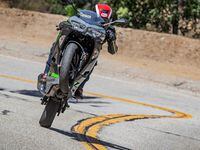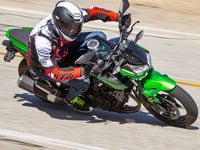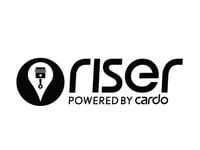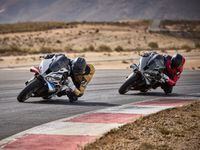Kawasaki wants riders of any skill level to taste its sporting pedigree. And for new riders, or those who simply want something small, fun, and affordable, it offers this pair of sub-$5,300 sport motorcycles in the shape of the 2019 Ninja 400 and Z400 ABS. This green duo is designed for entry-level riders who want to have as much fun as possible while learning the ropes.
Both bikes are powered by Kawasaki's all-new liquid-cooled 399cc parallel-twin. Introduced for the 2018 model year, this compact engine delivers 43.6 hp at 9,940 rpm and 24.6 pound-feet at 8,270 revs. It puts power back to the chain final drive through a slick-shifting six-speed gearbox and manual cable-actuated clutch.
The duo offers a powerband that has the best of both worlds: soft off the bottom, making the engine well suited to a novice learning to find the balance between the clutch and throttle. Yet it has enough immediate torque to get you moving from a stop without having to wind out the engine like you did on the previous-generation 250/300 engine. Gentle clutch engagement further complements the experience making it easy to get rolling from a stop.
"The engine in these two bikes is a new rider's dream come true," says our youngest, smallest, and most price-conscious 21-year-old tester, Evan Allen. "I like how smooth the power comes on initially. It just makes these bikes easy to ride."
Hard on the throttle both bikes deliver an exhilarating experience, that is, for entry-level bikes. Kawasaki motorcycles are known for punchy engine demeanor and menacing tone, so it’s nice to see the 400 duo incorporates this DNA. A hint of engine vibration is present above 7,000 rpm but we wouldn’t deem it excessive.
“The engine does vibrate a little bit at higher rpm,” Allen says. “But it sounds so good. I like the whine of the engine and the sound the bike makes as you upshift through the gearbox. It’s a fun bike to ride, regardless if you’re new to riding or have a couple years of seat time.”
While the powertrain on the green bikes feel identical, the chassis and the way the rider interacts with the machine is more diverse. Specifically, the Z400 benefits from a more traditional one-piece handlebar versus the Ninja 400’s above the top clamp clip-on-style bars.
The Z400 isn't necessarily more sporty feeling, but it does have a more natural bend, that's as well suited to city riding as it is hunting apexes around curves. One gripe: The Z400's side shrouds can dig into the inside of tall rider's knees. On the other hand the Ninja's hand controls aren't as agreeable, feeling almost tricycle-like, especially when compared to other fairing-equipped sportbikes.
“This is one of the major differences between the bikes. The Ninja 400’s clip-ons make for a more forward-biased riding position. It left me a little sore on surface streets,” tells the kid. “But it returns the favor in the twisties. The Z400 on the other hand was comfortable everywhere.”
Although we favored the Z400’s handlebar, there’s no doubt the Ninja 400 is the superior machine when logging highway miles. The addition of the fairing and windscreen do an admirable job of shielding the rider from wind and road debris.
"On the freeway the Ninja certainly blocks more wind," Allen confirms. "But the Z400 is still more comfortable overall. For a naked bike, it is a pretty smooth ride. It didn't create excessive turbulent air that was disrupting."
A negative-lit (white numbers on black face) display keeps tabs on each machine’s vitals. Kawasaki opted to use separate faces on its Ninja and Z bikes. Both readouts relay the same information, including handy gear position indicators, fuel level, and mileage functions. But overall, we prefer the appearance of the Ninja’s more conventional-looking setup, with its large round face analog-style tachometer versus the Z’s all-digital readout with the tachometer integrated at the top of the face.
Fuel-mileage-wise, the Ninja 400 recorded a 45.9 mpg average while the Z400 registered slightly less at 45.4 mpg—a possible nod to the more slippery aero of the Ninja. This equates roughly to a 166-mile range based on the 3.7-gallon capacity of the fuel tank.
On the scale, the Z weighs 7 pounds less than the 371-pound Ninja, mostly due to fewer body panels. You’ll be hard pressed to feel the difference though, at any speed.
In terms of handling, we were surprised by how adept either bike performed over bumpy surfaces. Handling is equally favorable on smooth twisty stretches of tarmac. Despite not offering adjustment, the fixed damping circuits control suspension movement well and offer a cushy, well-damping ride, in a similar vein to Kawasaki’s current-generation Ninja ZX-6R. Although the Z400’s suspension components employ softer springs, the difference is negligible. That is, until squeezing hard on the front brake lever. Still, it’s nice to know Kawasaki pays attention to subtle details.
“Both bikes offer a plush ride. Yet the suspension holds up and performs well when ridden at a quick pace. Plus they are agile,” Allen says, smiling. “It feels weird saying this, but they felt like they were on rails.”
Both machines roll on Dunlop’s excellent GPR-300 rubber. Despite being a price-point tire, the performance is anything but, with the tires offering above average grip in the dry and a more rigid carcass construction that stiffens the ride slightly during fast-paced riding in the canyons.
Braking hardware is also shared between machines. Both Kawasakis employ a large-diameter 310mm vented disc that’s pinched by an axial-mount twin-piston Nissin caliper. Another identical caliper squeezes a smaller 220mm disc at the rear. Aside from slightly squishier suspension feel up front during hard stops with the Z, the braking performance is identical with an above average level of feel and speed-shedding power when either pedal is pressed. ABS is standard on the $4,799 Z400, but offered as a $300 up-charge on the Ninja, elevating MSRP to $5,299.
Aside from price, the real question is whether to fairing or not. Riders who anticipate logging a fair amount of mileage on the freeway will appreciate the streamlined body panels and windscreen of the Ninja. They’ll also be pleased that their machine looks similar to the $9,999 Ninja ZX-6R. Still, the Z400 drives a hard bargain. It’s priced $500 less than the Ninja, and includes ABS as a standard feature. The traditional handlebar functions better overall, plus the Z400 is lighter—even if you can’t necessarily feel that when riding.
“Both bikes performed great and truly impressed me, but again, if I was going to buy one, I would choose the Z400,” Allen sums.
Helmet: Shoei RF-1200 Recounter Jacket: Icon Overlord Stim Gloves: Icon Hypersport Short Pant: Alpinestars Crank Denim Boots: TCX X-Wave Air
Helmet: Bell Star MIPS Jacket: Alpinestars Dyno V2 Leather Jacket Gloves: Alpinestars Celer Leather Glove Pant: Alpinestars Oscar Charlie Denim Pant













/cloudfront-us-east-1.images.arcpublishing.com/octane/VZEG2EJI2RDFZNHLRZMU56MD3Q.jpg)
/cloudfront-us-east-1.images.arcpublishing.com/octane/GVJQO5FFOFBWNGODOBRB4FBAW4.jpg)
/cloudfront-us-east-1.images.arcpublishing.com/octane/BIVAK2SFIBDJJM25E7I5VU2FJE.jpg)
/cloudfront-us-east-1.images.arcpublishing.com/octane/CH5VX52UG5CFHOVH5A6UYEFWWA.jpg)
/cloudfront-us-east-1.images.arcpublishing.com/octane/ZVGJNGZRU5C33N7KN23BBFKSC4.jpg)


/cloudfront-us-east-1.images.arcpublishing.com/octane/CZ5OM3E43ZEXJHY7LCYXCHLIKI.jpg)
/cloudfront-us-east-1.images.arcpublishing.com/octane/DF5T4K5KPZFJXFCTGPYR77PKJM.jpg)
/cloudfront-us-east-1.images.arcpublishing.com/octane/RMCT2KVQBJHBZMRTSLOVPMOILU.jpg)

/cloudfront-us-east-1.images.arcpublishing.com/octane/K45KB2XHQVA65DX7VN4ZSMT2BI.jpg)
/cloudfront-us-east-1.images.arcpublishing.com/octane/FNHXQQ56BRD7TO4YIJ453PNG2M.jpg)
/cloudfront-us-east-1.images.arcpublishing.com/octane/OIKJC4JA3ZH7BMKUGWYKBIY5FA.jpg)
/cloudfront-us-east-1.images.arcpublishing.com/octane/MT2SAEWY6FDXFBYSLDE3AEFDTM.jpg)
/cloudfront-us-east-1.images.arcpublishing.com/octane/66UPKPYVURBPRCP5HXSN56MEMM.jpg)
/cloudfront-us-east-1.images.arcpublishing.com/octane/EOREGDSRKFDCRJC6K3EDVHBGCE.jpg)
/cloudfront-us-east-1.images.arcpublishing.com/octane/42RF63Q3LVCMBP3DGTWXFYSMOA.jpg)
/cloudfront-us-east-1.images.arcpublishing.com/octane/XNVY3EVWZFCEVPUGJGAN633LXE.jpg)
/cloudfront-us-east-1.images.arcpublishing.com/octane/2PLTVHXY7FDSPFHKU5CFOC43ZY.jpg)
/cloudfront-us-east-1.images.arcpublishing.com/octane/B6M3WTRLFZGNXBEATNXPVGBBD4.jpg)
/cloudfront-us-east-1.images.arcpublishing.com/octane/4CMH3FI73BEM5D6MFYX42FLDSQ.jpg)
/cloudfront-us-east-1.images.arcpublishing.com/octane/RIHAPYNWU5H3XAOXNOPRWCBTQA.jpg)
/cloudfront-us-east-1.images.arcpublishing.com/octane/HU4NUBCL3VAFZA75VYRCMAUHVM.jpg)